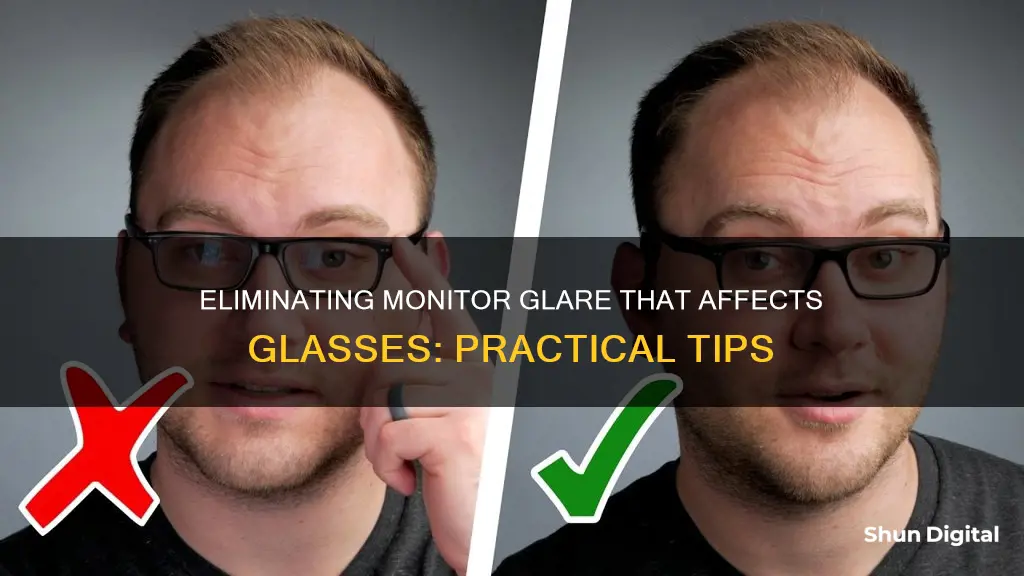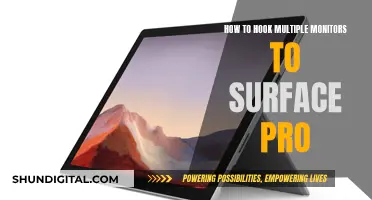
Glare on glasses can be a frustrating issue for those who use screens, especially when working remotely. While it is almost impossible to avoid completely, there are several ways to reduce it. Firstly, you can adjust your lighting. Try moving your light source so it is above head height and to the side, or increase the ambient room light. You could also try using a soft light, which makes reflections less noticeable, or turn your wall into a broad light source by pointing lamps at it. If you are facing a window, try turning away until the reflection disappears. You can also adjust your glasses themselves by tilting them or moving them slightly down your nose to change the angle of reflection. Finally, you can try adjusting your screen, either by dimming it or attaching an anti-glare filter.
| Characteristics | Values |
|---|---|
| Lighting position | Lights should be positioned to the side, above head height and angled slightly away from the camera |
| Number of lights | Two lights are recommended |
| Light type | LED panels with diffusers, soft light, or a softbox lighting kit |
| Light intensity | Increase the level of ambient room light |
| Light source size | Increase the size of the light source |
| Screen brightness | Lower the brightness of the computer display screen |
| Screen filters | Attach an anti-glare monitor filter to the display |
| Glasses coating | Use anti-glare or anti-reflective coating on glasses |
| Glasses position | Tilt glasses down and adjust the angle of the lenses |
What You'll Learn

Move your light source above head height and to the side
To remove glare on glasses from a monitor, one effective method is to adjust your lighting setup. This involves moving your light source above your head height and to the side. Here are some detailed instructions to help you implement this technique successfully:
Firstly, identify the light source in your setup. This could be a desk lamp, a ring light, or any other lighting equipment you use. Once you've located the light source, adjust its position by moving it above your head. A simple way to do this is to raise the lamp or light by 6 to 12 inches. This vertical adjustment will increase the angle between the light, your glasses, and the monitor, reducing the reflection of light back into the webcam.
However, raising the light alone might introduce shadows from your glasses frames and make the lighting appear flat. To address this, you can also move the light source to one side of your setup. This horizontal adjustment will not only help with glare but also improve the lighting across your face by adding definition to your facial features. Play around with the positioning until you find the right balance between reducing glare and achieving flattering lighting on your face.
If moving the light source to the side creates deep shadows, you can fill them in by using a reflector or a second light source on the opposite side. A simple reflector can be created by using white foam board or attaching sheets of white printer paper to a cardboard box. This will bounce light back into the shadows, softening them and creating a more even lighting effect.
Another important tip to remember is to avoid looking directly at the light source. By doing so, you create the perfect angle for the light to reflect off your glasses and into the webcam, bringing back the glare. Instead, maintain eye-level contact with the camera and avoid the urge to look elsewhere.
Additionally, consider the size of your light source. Generally, the larger the light source, the less glare you will have on your glasses. Using a softbox or a similar light modifier can help increase the size of the light source and create softer, more flattering light.
By following these instructions and experimenting with your lighting setup, you should be able to effectively reduce glare on your glasses from a monitor by moving your light source above head height and to the side.
Double Monitor Wallpaper: What Size Do You Need?
You may want to see also

Use a large soft light to make reflections less noticeable
A soft light is a light bulb with a large light modifier in front. The light modifier is usually made of white nylon fine mesh or a translucent white plastic material. The purpose of the light modifier is to turn a small source of light (the bulb) into a large source of light. This produces a quality of light known as soft light. With this light source, the illumination comes from every point on the light modifier, or seemingly from many directions. So only shadows caused by light from one point on the modifier will be filled in by light from all the other points on the light modifier, blurring those shadows.
A single bare bulb, on the other hand, produces light from one point, which is called hard light. It will cast hard shadows with well-defined edges that are very noticeable. A large soft light will be less noticeable on your glasses than a simple bare bulb.
If you must place your light behind the webcam and have some extra space, consider getting a soft light. These could be a traditional softbox, shoot-through umbrella light, or an umbrella softbox. Even if you can't raise the soft light, it will still reflect off your glasses. However, because the front of the soft light is large, the glare on your glasses will appear to be reduced.
As we've already seen, raising the light and moving it to the side will avoid the reflection of the light back into the webcam's lens. But there's an advantage in using a soft light instead of a desk lamp. Because a large soft light is less noticeable as glare on your glasses, you'll have more freedom in where you can look. If you occasionally glance towards the light, it won't matter because there will be a lot less of that bright reflection.
The other benefit of using a soft light is that they have a flattering effect. The soft light tends to wrap around your features, smoothing out shadows. That's great news if you have a wrinkle or two because that smoothing of shadows will help to make any lines and wrinkles less noticeable.
H2S Monitors: Where to Buy Them Safely
You may want to see also

Turn your wall into a broad light source
Turning your wall into a broad light source is an effective way to reduce glare on your glasses from your monitor. Here's how to do it:
First, assess your setup. If you have a wall behind your desk, that's great. Ideally, this wall is white, as white walls act as natural diffusers and reflectors of light. If your wall is not white, don't worry—there are easy ways to work around this.
Next, consider your lighting. You'll want to use bright lights, such as "white light" or "bright daylight" LED bulbs, which can emit up to 2550 lumens. You can also use a soft light, such as a softbox, umbrella light, or shoot-through umbrella light, which will soften the light and reduce harsh shadows.
Now, it's time to set up your lights. Point your chosen lights at the wall behind your desk, ideally at eye level. This will turn your wall into a broad, soft light source, illuminating your face with soft light. Because the light source is broad and tall, any reflection on your glasses will be much less noticeable than if you had a bright light directly in front of you. Additionally, the soft light will smooth out shadows and have a flattering effect on your facial features.
If your wall is not white, you can prop up a couple of sheets of 20"x30" foam core board against the wall. This will diffuse and divert the light, reducing glare. Alternatively, if you have wallpaper, you can tape some of it (pattern side down) to your wall.
Finally, play around with the positioning of your setup. As a general rule, any light source that is directly opposite your face is more likely to cause an unwanted reflection. Try moving your desk, monitor, and lighting to different angles to find the setup that works best for you.
By turning your wall into a broad light source, you can effectively reduce glare on your glasses from your monitor and improve your lighting setup for video calls and conferences.
LCD Monitors: Understanding Voltage Requirements
You may want to see also

Use window light at an angle
If you're facing a window, you will likely experience glare on your glasses. To avoid this, you can turn away from the window until the reflection disappears. The amount you will need to turn depends on the size of your window and the curve of your spectacle lenses.
Before moving your setup, test the angle with your smartphone camera. Hold it at arm's length and turn away from the window until the window reflection in your glasses disappears. This will give you an indication of where to position your laptop or webcam.
You can also use a reflector, such as a white foam board, to bounce window light into the shadows on the side of your face that is furthest from the window.
Omron Body Composition Monitor: Where to Buy in Singapore?
You may want to see also

Lower the brightness of your computer display screen
The computer screen is a significant source of glare, especially at night. To reduce glare, you can lower the brightness of your display screen. This is a simple yet effective way to minimise the glare and improve your viewing experience.
Lowering the brightness of your screen can be done in conjunction with other methods to reduce glare, such as adjusting the monitor's tilt and swivel to move it away from the source of light. You can also try to increase the ambient lighting in your room or office, so that the screen is not the only or the brightest source of light.
However, it is important to note that lowering the brightness of your screen may affect your ability to see other participants on a video call, or to use the menu and controls of the video conferencing app. It may also not be a suitable option if you need to share your screen during a call.
Additionally, reducing the screen brightness may introduce greater power usage, especially for laptops and other portable, battery-powered devices. It is also important to be mindful of the potential risk of eye strain when using a screen with reduced brightness.
Therefore, while lowering the brightness of your computer display screen can be an effective way to reduce glare, it should be combined with other methods and practised to find the best setup for your specific needs and environment.
Touch Monitors: Worth the Investment?
You may want to see also
Frequently asked questions
Try moving your light source so it is above head height and to the side.
You could try using a large soft light to make reflections less noticeable.
Yes, you could try tilting your glasses or adjusting your monitor.
You could consider investing in glasses with an anti-glare coating, or trying contact lenses.







